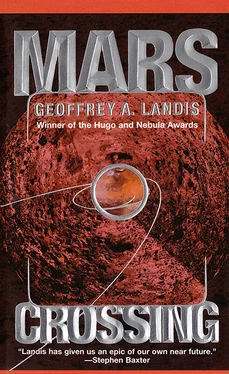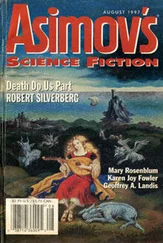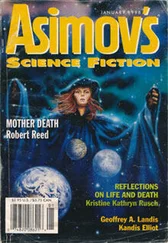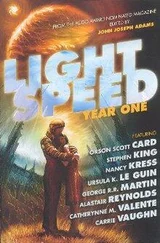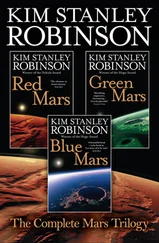A month before the landing, when Mars was little more than a small yellow smudge on the velvet sky, Ryan Martin had complained, “I’m going out of my mind. I don’t care what happens on Mars, just so long as it’s not fucking boring .”
“And I don’t care if I never see the inside of this damn cabin again,” Trevor Whitman added.
As circumstances would have it, they both had their wishes granted.
As the systems engineer, the task of checking out Dulcinea and certifying her ready for launch was Ryan Martin’s responsibility. Chamlong Limpigomolchai, the Thai geologist, had cross-trained on the propellant manufacturing plant, and probably was more familiar with its workings than Ryan was. He was Ryan’s assistant and backup on the EVA.
EVA—what an awkward term. Extravehicular activity. They had agreed before the mission that they would root out and destroy all of the confusing acronyms that space missions were prone to use, but somehow the use of the term “EVA” for any venture through the airlock of the Quijote ’s cabin had slipped out of their net. They needed a new word. Marswalk, maybe.
Okay. He walked over and touched Cham on the shoulder. “Ready for a Marswalk over to the Dulcinea ?” he asked.
“I’m go,” Chamlong said.
“Then let’s suit up.”
Ryan’s suit was a light blue and sported a Canadian maple leaf painted on the chest. Each suit was color coded, to avoid possible confusion as to which astronaut was out on the surface at any given time. Chamlong’s was the one with yellow-and-black stripes, and had the icon of an elephant neatly painted on the front.
The Martian EVA suits—Marswalking suits—were a marvel of engineering. They had a hard shell for the torso with armadillo joints at the abdomen, shoulders, and crotch. The chest carapace was made from a lightweight composite, coated on the outside with an inch of foam thermal insulation. The sleeves, gloves, and leggings were piezoelectric fabric, as light and flexible as ordinary cloth, but woven out of a fiber that contracted with an electrical signal to a perfectly contoured pressure fit around the limbs. It was a compromise design: The chest carapace allowed easy breathing, and the contractile fiber allowed free arm and leg motion. The only bad part was that you couldn’t scratch your nose. It seemed to Ryan that his nose always started to itch just the instant he put the bubble helmet over his shoulders. He had discovered that if he twisted his head to the side and stretched his neck, he could rub his nose against the radio speaker mounted just above his shoulders.
Each suit had a thermophotovoltaic isotope generator mounted in the middle of the back, which provided electrical power for the oxygen production machinery. Heat from the radioactive isotope’s decay was pumped through capillary-sized tubes in an undergarment to keep the chest and abdomen warm; the arms and legs were electrically heated to keep the astronauts from frostbite in the subzero Mars temperatures.
The tough silicon-carbide bubble helmets absorbed ultraviolet and had a visor like a baseball cap that could be turned to keep the sun-glare out of your eyes, as well as a second dark visor that could be pulled down like sunglasses.
All in all, they were practical suits, providing a self-contained Earthlike environment for traveling on Mars. On longer Marswalks, like all space suits, the suits would collect feces and urine for recycling. Ryan had long ago learned that when an astronaut stops in the middle of a task with an abstracted look on his face, it is proper to look the other direction and not bother them for a moment.
Once they had suited up, checked each other’s suits, and descended to the surface, it was only a short trek over to the Dulcinea . The upper stage and the four huge booster tanks sat on the sand like a slightly battered beer can surrounded by ostrich eggs. The whole assembly rested on four mantis legs.
Ryan circled her, doing an external inspection. Both of the oxygen tanks were venting a thin, wispy trail of white vapor. That was okay: it indicated that the tanks were full. The zinc white of the thermal paint on the booster tanks was shaded lightly pink at the bottom with dust; that was expected, though, and the thermal modeling allowed for it. Other than that, there was no external damage visible.
“So far she looks okay,” he said slowly. There still seemed something just a little bit odd about the condition of the ship, as if there was something he should have been seeing but wasn’t, but he couldn’t put a finger on what it might be. “Anything look out of place to you?”
“Negative here,” Cham replied.
“Pretty good condition for an old lady who’s been sitting out in the cold for six and a half years,” he concluded. Maybe that was all it was; he had expected the ship to look more worn, dirty, and wind-battered from half a decade of exposure on the surface.
Between the number two and number three booster tanks was an access ladder that led to a small circular hatch. He climbed up while Chamlong waited on the sand below. The hatch release rotated freely, and he unsealed the hatch and wriggled through the opening, which was just barely big enough to take a Mars suit. An awkward design, but for the return ship every kilogram counted, and there was no need for a hatch that would allow a more dignified entrance. Inside, he flipped the circuit breakers on, and lights illuminated the cabin.
It was a near duplicate of the cabin on Quijote , except for the presence of an additional set of indicator panels for the chemical machinery that had manufactured the fuel. The computer system was already running. He powered up the CRT to read out the internal displays, and while it was coming to life, looked over the mechanical gauges.
They had checked the fuel a hundred times by radio link, both before launch from Earth and during flight. But from the gauges inside the cabin, the indicators didn’t make any sense. What they showed should have been impossible. The computer came up, and he turned his attention to it. It didn’t make any sense, either.
Chamlong poked through the hatch and took a look at him. “What is it?”
“Wait one,” he said. He sat down at the system engineer’s station, staring at the readings but not really seeing them. What was different?
Dulcinea had been designed to sit on Mars for two years, making propellant for the return mission. It had instead been sitting on Mars for nearly seven, waiting for her crew. But it still had propellant; the almost invisible plume of white vapor from the tanks proved that. So why were the sensors wrong? The mechanical gauges for the two oxygen tanks read zero; the two pressure gauges read screwy—one tank impossibly high, two other tanks way too low.
Ice, he thought. Mars is cold and dry, and the Martian atmosphere contains very little water vapor. But over the course of seven years, the tiny hit of humidity the air did hold would condense onto the cryogenic lines and freeze. Some ice could be clogging the sensors. That shouldn’t be a failure mode, but building up over seven years? He called up a schematic for the mechanical gauge and studied it.
Maybe. He showed the drawing to Chamlong. “Right there,” he said. “The heat exchanger pipe for the intake manifold. Suppose it built up a layer of ice?”
“You think that could really happen?”
Ryan shrugged. “Got any other ideas?”
Chamlong looked at the drawing. His doctorate was in planetary science, but he also had a mechanical engineering degree and a good understanding of the mechanism. “If I were to go down and tap on the manifold, if there’s ice on it, it might break it free.”
Читать дальше
